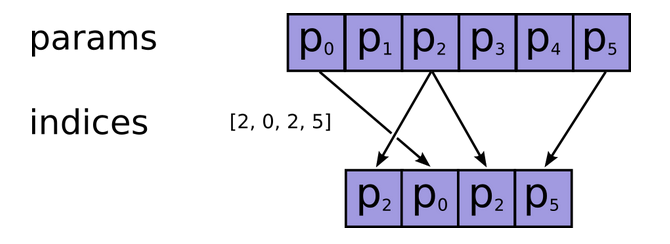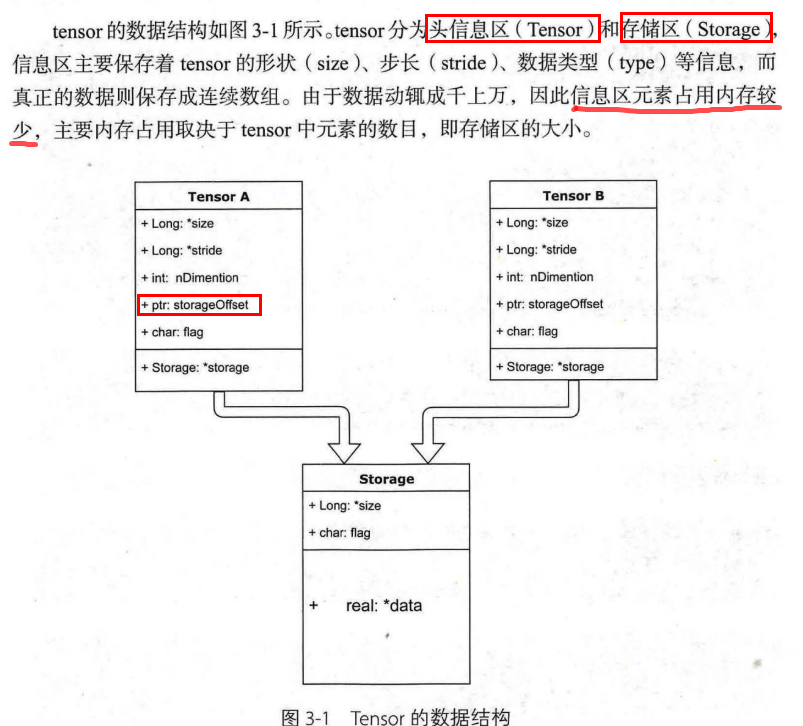文章目录
一、Torch 简介
1、Torch 最重要的特点及功能
- N 维数组对象(tensor):该对象是存储单一数据类型的多维数组(可表示标量、向量、矩阵或张量等)
- 具有矢量运算和复杂广播能力,内存使用效率高
- 具有
线性代数、随机数生成以及傅里叶变换功能
2、Torch 与 Numpy 的区别与联系
- Numpy 定位是各种各样的
科学计算,其在CPU上比较快 - TF 和 Torch 等的定位是
机器学习,它们在 Numpy 的基础上做了扩展,使其支持GPU 编程、分布式编程、自动微分等特性 torch==numpy, tensor==ndarray:torch is a Tensor library like NumPy, with strong GPU support
二、Tensor 使用
1. tensor 的创建
-
通过构造函数创建稠密矩阵和稀疏矩阵:
torch.tensor(data, dtype=None, device=None, requires_grad=False, pin_memory=False)- data: array_like,为 python 列表(list of list)、元组、数组、标量或其它
序列类型 - dtype:
torch.float32、torch.int32、torch.bool等 - device:
torch.device('cpu')、'cpu';cuda1=torch.device('cuda:1')、'cuda:1'、1等 - requires_grad: 是否需要求解梯度,默认
False
- data: array_like,为 python 列表(list of list)、元组、数组、标量或其它
torch.sparse_coo_tensor(indices, values, size=None, dtype=None, device=None, requires_grad=False)- indices: array_like,shape 为
2×N,N为非零元素的数量,第一维为横坐标,第二维为纵坐标 - values: array_like,非零元素的填充值
- size: 稀疏矩阵的形状,为 list, tuple, or torch.Size
- .to_dense() 方法: 可将稀疏矩阵转换为稠密矩阵
- indices: array_like,shape 为
-
通过内置函数创建:
torch.zeros(*size, out=None)、torch.ones(*size, out=None)、torch.empty(*size, out=None)、torch.full(size, fill_value, out=None):size 为 int(1dim) or tuple/list of ints(>=2dim)torch.zeros_like(input)、torch.ones_like(input)、torch.empty_like(input)、torch.full_like(input, fill_value):以另一个数组为参数,并根据其形状和dtype创建一个全 0、1、空等的数组torch.eye(scalar):创建一个形状为scalar*scalar的单位矩阵
-
通过随机数函数创建:
torch.rand(*size, out=None) & torch.rand_like(input):产生[0, 1)之间,形状为 size 的均匀分布(注意要带上参数)torch.normal(mean, std, size,):产生形状为 size 的正态分布 (注意要带上参数);torch.randn(3, 4)是其特例(标准正态分布,还有torch.randn_like(input))torch.randint(low=0, high, size) & torch.randint_like(input):Return random integers from low (inclusive) to high (exclusive)- 注意:使用时要带上参数
- 0.5 的概率:
if randint(0, 2, size=(1,)) : do something
torch.randperm(n):Returns a random permutation of integers from 0 to n - 1torch.manual_seed(integer):随机数种子,固定后可用于重现某一实验结果, 最好同时设置np.random.seed(0)、torch.manual_seed(0)、torch.cuda.manual_seed_all(0)Note:size 为 int or tuple of ints
-
通过序列函数创建:
torch.arange(start=0, end, step=1)创建:和 range 的区别是它返回的是数组而不是列表(不包括 end)torch.linspace(start, end, steps=100):产生 steps 个等距分布在[start, end]间元素组成的数组,包括start & end,步长为torch.logspace(start, end, steps=100, base=10.0):产生 steps 个对数等距分布的数组,包括start & end,基数默认以 10 为底数,可以通过base参数指定
2. tensor 的访问
-
索引(View)
- 一维数组的索引:和列表类似
(支持负索引arr[-3],但不支持负数步长) - 二维数组的索引:
arr[i, j] == arr[i][j] - 多维数组的索引:如果省略了后面的索引,则返回的对象会是一个维度低一点的
ndarray(但它含有高一级维度上的某条轴上的所有数据) - 条件索引:
arr[conditon] # conditon 可以使用 & | 进行多条件组合,应返回 ndarray- 布尔数组索引:仅返回结果的
一维数组,无论原数组是否是多维数组 - 整数数组索引:仅返回结果的
一维数组,无论原数组是否是多维数组>>> a tensor([1, 8, 4, 9, 6, 7, 2, 5, 0, 3]) # 布尔数组索引 >>> a > 5 tensor([False, True, False, True, True, True, False, False, False, False]) >>> a[a>5] tensor([8, 9, 6, 7]) # 整数数组(list)索引,数组为 array_like 即可(list or ndarray or tensor) >>> torch.where(a>5) (tensor([1, 3, 4, 5]),) >>> a tensor([8, 9, 6, 7]) >>>x = torch.arange(10, 1, -1) tensor([10, 9, 8, 7, 6, 5, 4, 3, 2]) >>>x[[3, 3, -3, 8]] # 一维时可使用 list 索引数组 tensor([7, 7, 4, 2]) # Mask an tensor where a condition is met >>> b = ma.masked_where(a<=5, a) masked_tensor(data=[--, 8, --, 9, 6, 7, --, --, --, --], mask=[ True, False, True, False, False, False, True, True, True, True], fill_value=999999) >>> b.mean() = 7.5 # 加了mask,只处理没被 mask 的数据 >>> a.mean() = 4.5 >>> b.set_fill_value(-1) >>> b.filled() # 注意 b.data == a, 并没有改变,只是结合 mask 使用 tensor([-1, 8, -1, 9, 6, 7, -1, -1, -1, -1]) - torch.where(condition, x=None, y=None):矢量版本的三元表达式
x if condition else y- If only
conditionis given, return the tuplecondition.nonzero(), the indices whereconditionis True# 1、一维数据 x = torch.arange(5) tensor([0, 1, 2, 3, 4]) torch.where(x>2) # 返回一个 tuple,第一个元素对应索引的坐标 (tensor([3, 4]),) # 2、二维数据 x = torch.arange(9.).reshape(3, 3) tensor([[0., 1., 2.], [3., 4., 5.], [6., 7., 8.]]) torch.where(x > 5) # 返回一个 tuple,第一个元素对应索引的 x 坐标,第二个元素对应索引 的 y 坐标 (tensor([2, 2, 2]), tensor([0, 1, 2])) - If both
xandyare specified, the output tensor contains elements ofxwhereconditionis True, and elements fromyelsewhere(x, y 必须为 tensor,且数据类型相同)# 1、一维数据 x = torch.arange(5) tensor([0, 1, 2, 3, 4]) torch.where(x > 2, x, torch.tensor(-1)) tensor([-1, -1, -1, 3, 4]) # 返回一个一维的 tensor # 2、二维数据 x = torch.arange(9.0).reshape(3, 3) torch.where(x<5, x, torch.tensor(-1.0)) # Note: broadcasting. tensor([[ 0., 1., 2.], # 返回一个二维的 tensor [ 3., 4., -1.], [-1., -1., -1.]])
- If only
- 布尔数组索引:仅返回结果的
- 一维数组的索引:和列表类似
-
切片(View)
- 一维数组的切片:和列表类似,不支持负数步长
- 二维数组的切片:
arr[r1:r2, c1:c2:step] # 也可指定 step 进行切片,尽量不要使用arr[][]这种形式的切片,因为后面括号是基于前面括号的结果,而只使用一个大括号则是共同考虑,没有先后顺序
3. tensor 的常用属性和方法
a、常用属性
- shape 属性:表示数组各个维度的大小,各个维度相乘之积即为 size 属性
- dtype 属性:表示数组中各数据类型(
默认 torch.int32, torch.float32、torch.bool),可通过type()方法转换数组的数据类型,也可通过type_as(tensorB)方法转换为张量 B 的 dtype - device 属性:表示数组放置的设备,可以是
torch.device('cpu')、'cpu';cuda1=torch.device('cuda:1')、'cuda:1'、1等 - requires_grad 属性:表示此变量是否需要求解梯度
b、常用方法
注意:函数名以下划线
_结尾的都是in place方式,会修改调用者自己的数据。
- Numpy 和 Tensor 互转的方法:
- t.numpy() 方法: 将 tensor 转换为 ndarray
- torch.from_numpy(n) or torch.as_tensor(n)方法:将 ndarray 转换为 tensor
- Numpy 和 Tensor 共享内存,当遇到 Tensor 不支持的操作时,可以先转成 Numpy 数组进行处理,然后再转回 tensor
- 数组在 CPU 和 GPU 上切换的方法:
- cuda() 方法:将 CPU 上的数据迁移到 GPU 上
- cpu() 方法:将 GPU 上的数据迁移到 CPU 上
- to() 方法:可以将当前数据迁移到指定设备,可以是
torch.device('cpu')、'cpu';cuda1=torch.device('cuda:1')、'cuda:1'、1等
- 改变数组形状的方法:
- reshape() 方法:
- 改变数组的维度大小(可以把一个一维的向量转换成一个二维的矩阵),返回原始数组的视图
- transpose(dim0, dim1) or premute() 方法:
- 一维数组的转置:不起作用(这和线代不同),可以先 reshape 到二维再转置
- 二维数组的转置:可用
arr.t() or arr.transpose(0, 1) or arr.permute(1,0) or torch.transpose(arr, 0, 1),返回原始数组的视图 - 高维数组的转置:需要得到一个由编号(0, 1, 2,…)组成的二元组才能对这些轴进行转置,本质是轴对换,
arr.permute(0,2,3,1) or arr.transpose(2, 0) or torch.transpose(arr, 2, 0),返回原始数组的视图 - 注意:
.t()方法只能转置二维数据;.transpose()方法可以多维交换,但每次只能交换两个维度;.permute()方法可以同时交换多个维度
- flatten()方法:
- 将多维数组转换为一维数组,可用
arr.reshape(-1), torch.reshape(arr, (-1,))、torch.flatten(arr)函数 arr.flatten()返回原始数组的拷贝,对拷贝所做的修改不会影响原始矩阵,而arr.ravel()返回的是视图(view),会影响原始矩阵
- 将多维数组转换为一维数组,可用
- unsqueeze(dim) 方法:在
dim 维插入长度为 1 的轴 - squeeze(dim=None) 方法: 剔除所有长度为 1 的轴,也可通过指定 dim 来剔除特定的轴
- reshape() 方法:
- 数组(数据类型)转换的方法:
- tolist() 方法:将数组转换成列表
- type(dtype) 方法:转换数组的数据类型,eg:
a = a.type(torch.float32),也可通过type_as(tensorB)方法转换为张量 B 的 dtype - float() 方法 和 int() 方法:转换为 float32 或 int32 的快捷方式
- 数组截断、取范数、Topk、kthvalue 的方法:
clamp(min, max)方法:
norm(p=2)方法:- 对输入的 tensor 求范数,默认 2 范数(所有元素平方开根号)
topk(k, dim=-1, largest=True, sorted=True)方法:- 返回一个 tuple,分别代表着从大到小排列的
topk个元素的值和在原数组中对应的索引(注意:值和索引与原数组的维数相同)
- 返回一个 tuple,分别代表着从大到小排列的
kthvalue(k, dim=-1, keepdim=False)方法:- 返回一个 tuple,分别代表着从
第 k 小(第 shape@dim - k 大)元素的值和在原数组中对应的索引
- 返回一个 tuple,分别代表着从
4. tensor 的常用函数
a、数组随机打乱、选择
-
torch.randperm(x): x is an integer, randomly permute torch.arange(x).>>> torch.randperm(6) tensor([4, 3, 1, 5, 0, 2]) -
torch.take(input, index):按展平的顺序取相应的元素,输出和输入 index 的形状相同>>>x = torch.arange(9).reshape(3, 3) tensor([[0, 1, 2], [3, 4, 5], [6, 7, 8]]) >>>torch.take(x, torch.tensor([[0, 1], [2, 3]])) # If indices is not one dimensional, the output also has these dimensions tensor([[0, 1], [2, 3]]) >>>torch.take(x, torch.tensor([0, 2, 2, 3])) tensor([0, 2, 2, 3])
-
torch.gather(input, dim, index):沿着 dim 收集新的 tensor,输出和输入 index 的形状相同For a 3-D tensor the output is specified by: out[i][j][k] = input[index[i][j][k]][j][k] # if dim == 0,按行看,(i,j,k 为 0~input.shape[:]) out[i][j][k] = input[i][index[i][j][k]][k] # if dim == 1,按列看 out[i][j][k] = input[i][j][index[i][j][k]] # if dim == 2 >>> t = torch.tensor([[1,2],[3,4]]) >>> torch.gather(t, 1, torch.tensor([[0,0],[1,0]])) tensor([[ 1, 1], [ 4, 3]]) >>> torch.gather(t, 0, torch.tensor([[0,0],[1,0]])) tensor([[ 1, 2], [ 3, 2]])
b、数组组合
-
torch.cat(tensors, dim=0, out=None)- tensors:以
元组形式给出,必须带括号,且除了需要拼接的维度(dim)外,其它维度要相等 - dim:用于拼接的维度,新数组第 dim 维为所有数组的第 dim 维之
和 - 作用:默认用于两个数组 batch 维度的
拼接
- tensors:以
-
torch.stack(tensors, dim=0, out=None)- tensors:以
元组形式给出,必须带括号,且除了需要拼接的维度(dim)外,其它维度要相等 - dim:插入新维度的位置,新维度 为 tensors 中元素的个数之
和 - 作用:会增加
新的维度,可以理解为叠加
>>> x = torch.randn(2, 3) >>> torch.cat((x, x), 0).shape torch.Size([4, 3]) >>>torch.stack((x, x), 0).shape torch.Size([2, 2, 3]) - tensors:以
c、数组分割
-
torch.split(tensor, split_size_or_sections, dim=0):每块多少元素- split_size_or_sections : (python:int) or (list(python:int)) ,size of a single chunk or list of sizes for each chunk
- 一维情形示例:
>>> x = torch.arange(9.0) >>> torch.split(x, 4) # 每块四个元素,不够分的单独放一块 (tensor([0., 1., 2., 3.]), tensor([4., 5., 6., 7.]), tensor([8.])) >>> torch.split(x, [3, 5, 1]) # 注意总和要和元素个数相同 (tensor([0., 1., 2.]), tensor([3., 4., 5., 6., 7.]), tensor([8.])) - 二维情形示例:
>>> x = torch.arange(12.).reshape(3,4) >>> torch.split(x, 2) (tensor([[0., 1., 2., 3.], [4., 5., 6., 7.]]), tensor([[ 8., 9., 10., 11.]])) >>> torch.split(x, [1, 2, 1], dim=1) # 注意总和要 dim 所在维度相同 (tensor([[0.], [4.], [8.]]), tensor([[ 1., 2.], [ 5., 6.], [ 9., 10.]]), tensor([[ 3.], [ 7.], [11.]]))
-
torch.chunk(input, chunks, dim=0):分成几块(chunks),如果可能的话分成整数份
d、数组复制
torch.repeat_interleave(input, repeats, dim=None):对数组中的每个元素进行连续重复复制(Copy)# Parameters: repeats : int or tensor of ints # The number of repetitions for each element. `repeats` is broadcasted to fit the shape of the given axis. axis : int, optional # The dimension along which to repeat values. By default, use the flattened input array, and return a flat output array. Examples -------- # 一维数据情况 x = torch.tensor([3]) torch.repeat_interleave(x, 4) tensor([3, 3, 3, 3]) # 二维数据情况,对每一个数据 repeat,然后 flatten x = torch.tensor([[1,2],[3,4]]) torch.repeat_interleave(x, 2) tensor([1, 1, 2, 2, 3, 3, 4, 4]) # 沿着水平坐标轴对每一个数据进行 repeat,不进行 flatten torch.repeat_interleave(x, 3, dim=1) tensor([[1, 1, 1, 2, 2, 2], [3, 3, 3, 4, 4, 4]]) # 沿着垂直坐标轴对每一个元素(这里是【1,2】和 【3,4】)进行 repeat,不进行 flatten torch.repeat_interleave(x, torch.tensor([1, 2]), dim=0) tensor([[1, 2], [3, 4], [3, 4]])arr.repeat(*sizes):对整个数组进行复制拼接(Copy)- sizes 的维数不能小于 arr 的维数
- 进行内存拷贝操作,输出形状为
dim0*repeats0, dim1*repeats1, ....
# 一维数据的情况 >>> a = torch.tensor([0, 1, 2]) >>> a.repeat(2) tensor([0, 1, 2, 0, 1, 2]) >>> a.repeat(2, 2) # 构建一个 2*2 的 copy tensor([[0, 1, 2, 0, 1, 2], [0, 1, 2, 0, 1, 2]]) # 二维数据的情况 >>> b = torch.tensor([[1, 2], [3, 4]]) >>> b.repeat(3, 2) tensor([[1, 2, 1, 2], [3, 4, 3, 4], [1, 2, 1, 2], [3, 4, 3, 4], [1, 2, 1, 2], [3, 4, 3, 4]]) # 可在最前面插入一维进行复制拼接 >>> b.repeat(3, 1, 1) tensor([[[1, 2], # shape(3,2,2) [3, 4]], [[1, 2], [3, 4]], [[1, 2], [3, 4]]])arr.expand(*sizes):对 维度为 1 的数据进行扩展(View)- 维度为 1 的地方:指定扩展多少倍(eg: 3),
-1 或 1表示不扩展 - 维度不为 1 的地方:不能进行扩展,否则会报错,指定维度为
-1 或 原始维度即可
# 一维数据的情况 >>> a = torch.tensor([3]) >>> a.expand(4) tensor([3, 3, 3, 3]) # 二维数据的情况 >>> b = torch.tensor([[3, 4]]) >>> b.expand(3, -1) or b.expand(3, 2) tensor([[3, 4], [3, 4], [3, 4]]) # 可在最前面插入一维进行扩展 >>> b.expand(3, -1, -1) tensor([[[3, 4]], # shape(3,1,2) [[3, 4]], [[3, 4]]]) # 三维的情况 >>> c = torch.tensor([[[3, 4]]]) # shape(1,1,2) >>> c.expand(3, -1, -1) or b.expand(3, 1, 2) tensor([[[3, 4]], # shape(3,1,2) [[3, 4]], [[3, 4]]])- 维度为 1 的地方:指定扩展多少倍(eg: 3),
5、tensor 的内存结构
- tensor 中绝大多数操作不更改其内存结构:
- 不同 tensor 的头信息一般不同,但却可能使用相同的 storage
- 可使用
id(a.storage()) == id(b.storage())来判断 a 和 b 的内存地址是否一样(一个对象的 id 可以看作在其在内存中的地址) - 可使用
a.data_ptr()查看 a 的内存地址、a.storage_offset()查看 a 的偏移量(bytes)

- 高级索引一般不共享 storage:
- 普通索引可以通过修改 offset、stride 和 size 实现
- 高级索容易导致 tensor 不连续(可通过
a.is_contiguous()判断) a.contiguous():将存储空间转为连续(复制数据到新的内存)后,你可以高效且有序地访问它们的元素而不是在存储中四处跳跃访问
三、通用函数(ufunc): 元素级运算
1. 常用的通用函数
一元通用函数- torch.ceil():取向上最接近的整数
- torch.floor():取向下最接近的整数
- torch.round():四舍五入
- torch.trunc():返回整数部分数值
- torch.frac():返回小数部分数值
- torch.abs():计算各元素的绝对值
- torch.exp():计算各元素的指数
- torch.sqrt():计算各元素的平方根
- torch.log()、torch.log2()、torch.log10():分别为以 e 、2、 10 为底的元素级对数运算
- torch.tan()、torch.tanh()、torch.sin()、torch.cos():三角函数的元素级运算
- torch.sigmoid(input, out=None)
- torch.softmax(input, out=None)
二元通用函数torch.add(x1, x2)、torch.sub(x1, x2)、torch.mul(x1, x2)、torch.div(x1, x2)、torch.fmod(x1, x2)、torch.pow(x1, x2):元素级加减乘除、取余及指数运算,当第二个数为标量时,将进行broadcast运算(需保证数据类型相同)torch.matmul(x1, x2):使用此函数实现矩阵乘积(一维相乘返回乘积之和)torch.maximum(x1, x2)、torch.minimum(x1, x2):- 逐元素比较取其大/小者,当第二个数为标量时,将进行
broadcast运算 x1, x2可以为 n 维 tensor,此时将逐元素比较取大者或小者a = torch.tensor([1,3]); b = torch.tensor([2,4]); torch.maximum(a,b)=tensor([2, 4])
- 逐元素比较取其大/小者,当第二个数为标量时,将进行
torch.eq(x1, x2)、torch.ne(x1, x2)、torch.gt(x1, x2)、torch.ge(x1, x2)、torch.lt(x1, x2)、torch.le(x1, x2):- 元素级比较元素,返回布尔型值(形状和原数组相同)
torch.equal(x1, x2):整体比较,返回一个布尔值torch.logical_and(x1, x2)、torch.logical_or(x1, x2)、torch.logical_xor(x1, x2):- 元素级逻辑运算,返回布尔型值
2. 常用的统计方法
多维数组做统计时要指定统计的维度(
eg: torch.mean(input, dim, keepdim=False)),否则默认是在全部维度上做统计
- keepdims=True:dim 是几,那就表明哪一维度
被压缩成 1 维- keepdims=False:dim 是几,那就表明哪一维度
被干掉了,新数组的形状由剩余的维度组成的- 注意:大多数方法都要求输入
浮点型数据
- torch.mean(),torch.sum():取均值和累积和
- torch.std(),torch.var():标准差和方差
- torch.max(),torch.min():返回原数组的最大值和最小值(一个 tensor);返回元素级比较中较大或较小的(二个 tensor)
- torch.sort(input, dim=-1):从小到大排序,返回排序后的数组和索引
- torch.prod():求所有元素或某一轴上所有元素的乘积
- torch.argmax(),torch.argmin():最大和最小元素的索引(内存上一维的索引)
- torch.argsort(x, dim=-1),torch.argsort(-x, dim=-1):取得从小到大或从大到小排序的索引
- torch.argwhere(condition):找出符合条件元素的索引
- torch.all(a, axis=None): 全部满足条件
- torch.any(a, axis=None):至少有一个满足条件
- torch.unique(a, sorted=True):找到唯一值并返回排序后的结果
来源:CSDN
作者:man_world
链接:https://blog.csdn.net/mzpmzk/article/details/104231752



